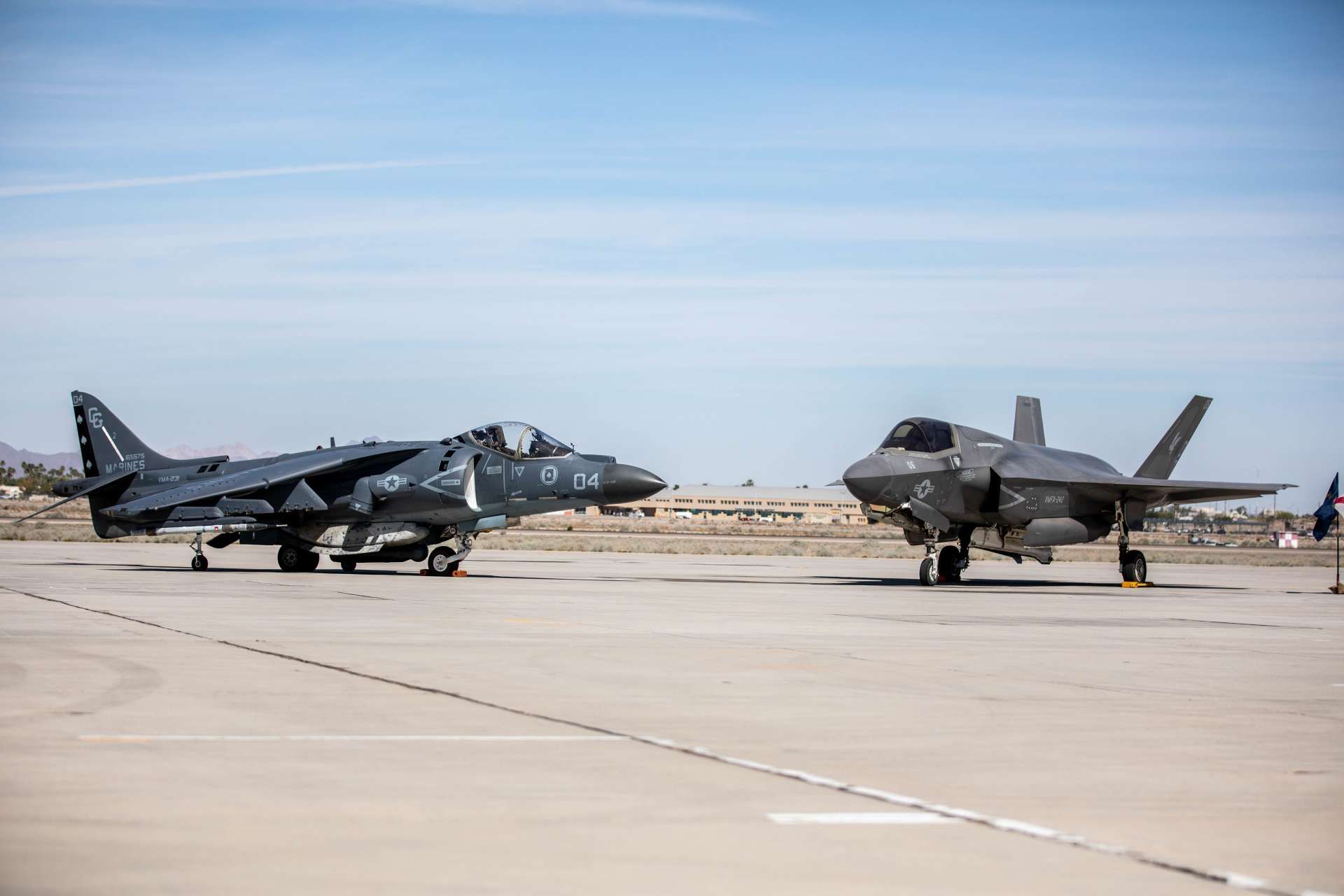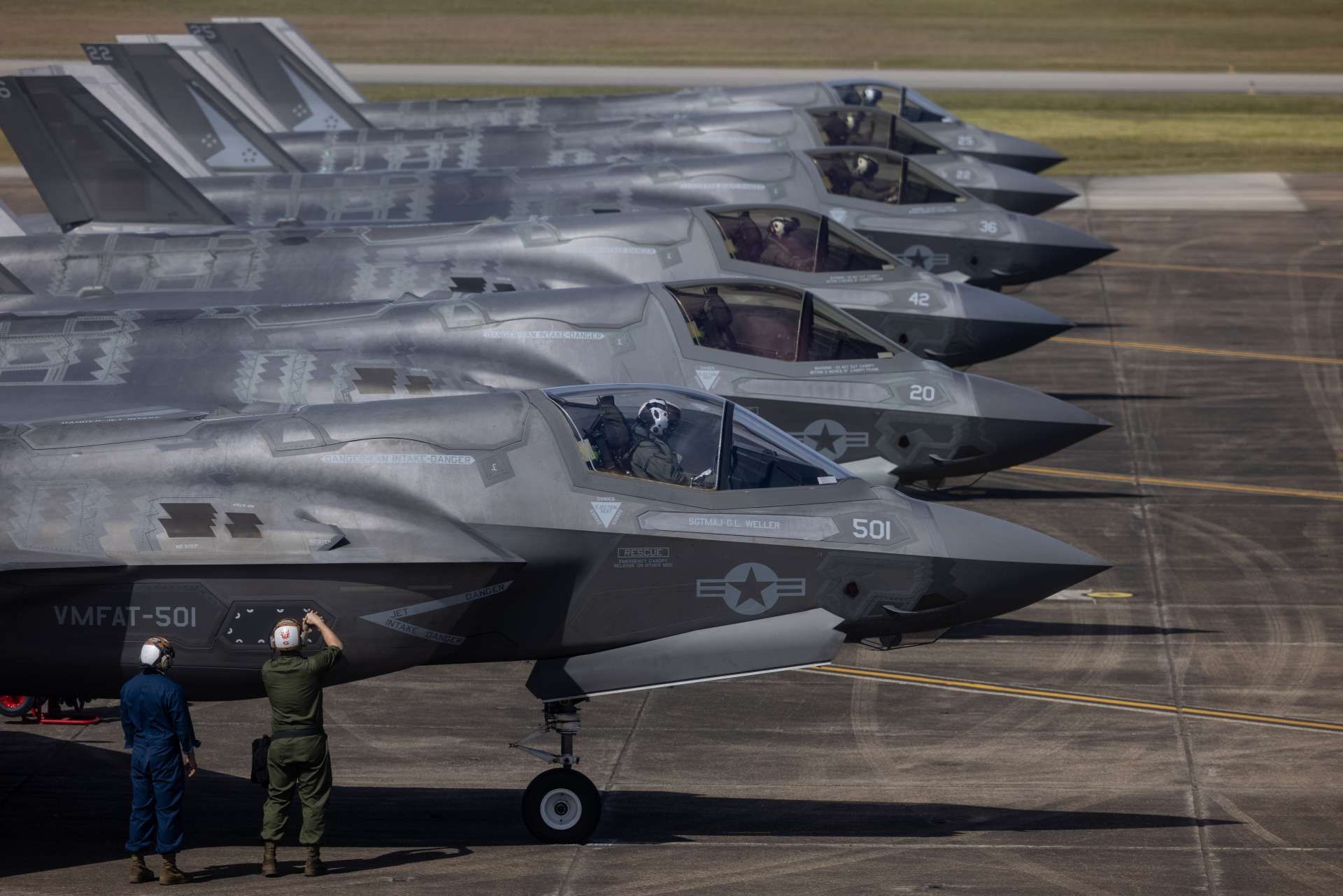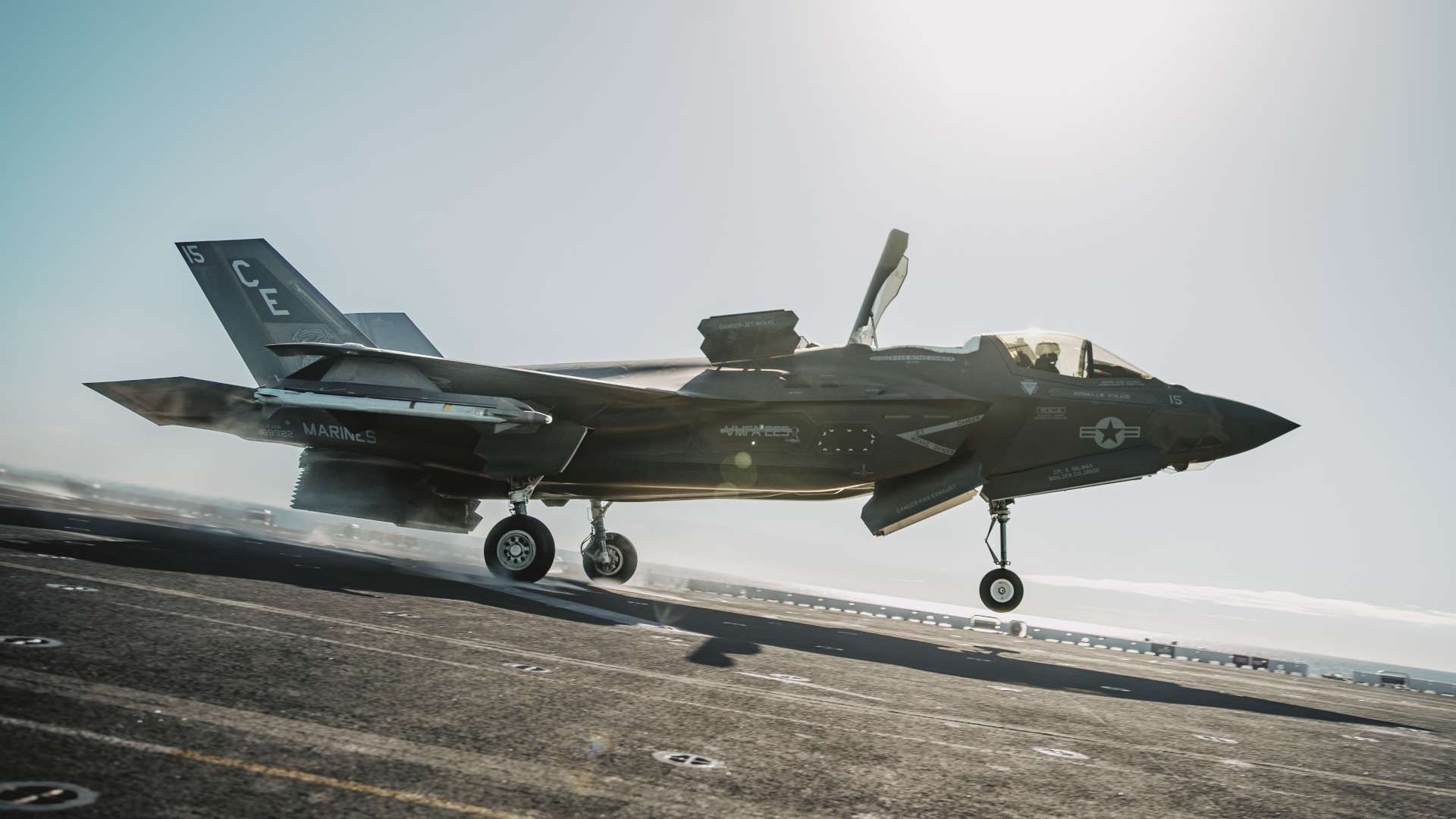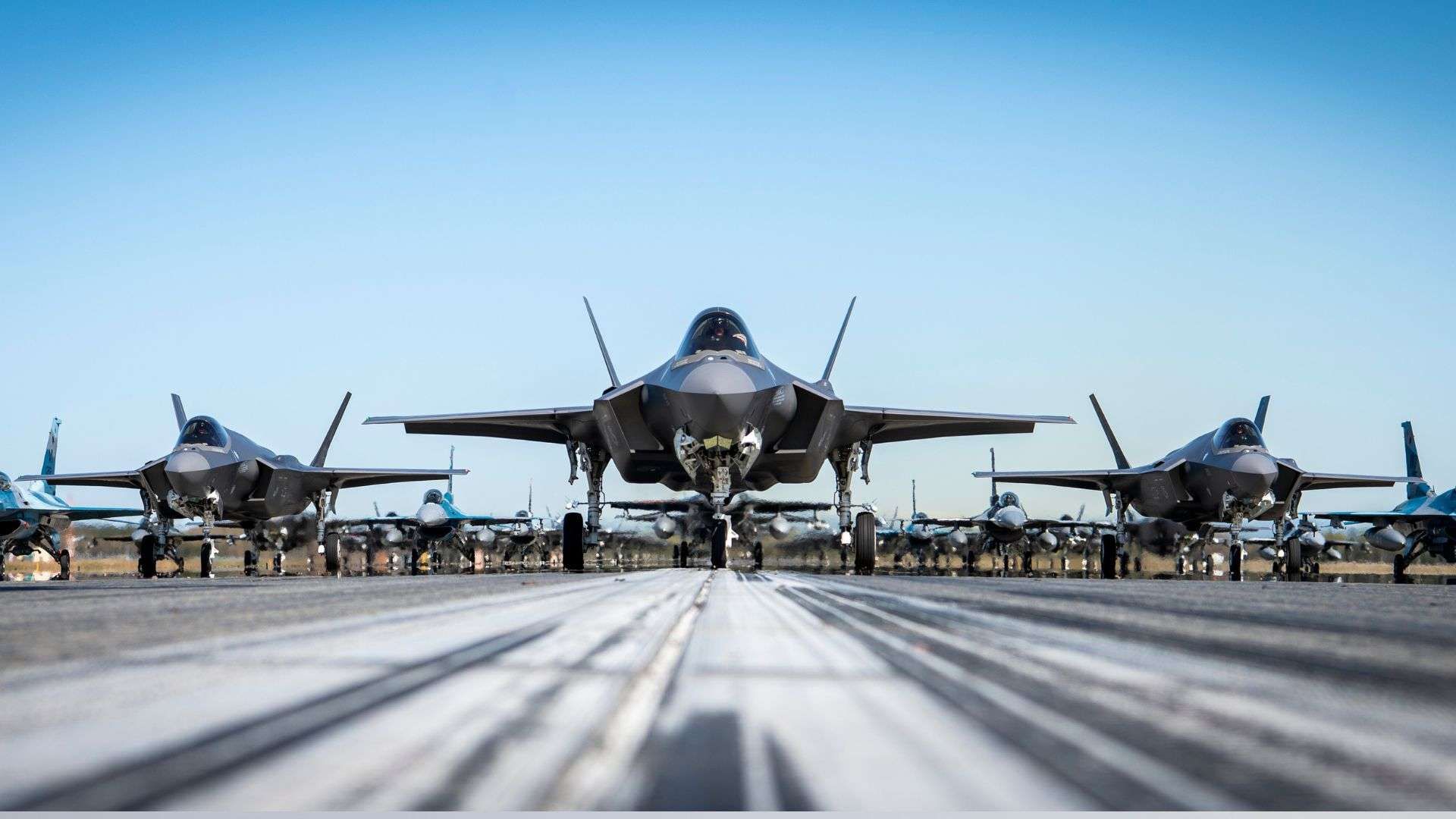Breaking News
US Marine Corps famous America's Squadron welcomes first F-35B Block 4 stealth fighter.
On October 11, 2024, the US Marine Corps' Fighter Attack Squadron VMFA-533, under Marine Aircraft Group (MAG) 31 and part of the 2nd Marine Aircraft Wing (MAW), received its first F-35B Lightning II Block 4 stealth fighter jet at Marine Corps Air Station (MCAS) Beaufort, South Carolina. This arrival establishes VMFA-533 as the Marine Corps’ second operational F-35B squadron on the East Coast and the first operational F-35B squadron at MCAS Beaufort.
Follow Army Recognition on Google News at this link

The F-35B Block 4's arrival establishes the VMFA-533 as the Marine Corps’ second operational F-35B squadron on the East Coast and the first operational F-35B squadron at MCAS Beaufort. (Picture source: US DoD)
Prior to this, only the US Marine Fighter Attack Training Squadron 501 operated F-35 aircraft at the station, focusing on core introduction and fighter/attack training for new F-35 pilots. VMFA-533, known as “America’s Squadron” for its red, white, and blue insignia, has a history that dates back to 1943. It was initially commissioned as Marine Night Fighter Squadron 533 (VMF[N]-533) and has operated various aircraft over the decades, including the F6F Hellcat, F7F Tigercat, F2H Banshee, F9F Cougar, and A-4 Skyhawk.
In 1965, the squadron transitioned to the A-6 Intruder and was redesignated Marine Attack Squadron 533 (VMA-533). In 1992, it converted to the F/A-18 Hornet, remaining an F/A-18 unit for 31 years until its redesignation to VMFA-533 in September 2023. Since then, the squadron has completed preparations for the F-35 transition, including achieving “Safe for Flight” certification. The arrival of the F-35B to VMFA-533 initiates deliveries to MCAS Beaufort’s operational squadrons and continues the 2nd MAW’s transition from legacy fixed-wing tactical aircraft to the F-35 platform.
The F-35 Lightning II, developed by Lockheed Martin as part of the U.S. Joint Strike Fighter (JSF) program starting in 1995, aimed to create a versatile stealth fighter to replace multiple aging aircraft such as the F-16 Fighting Falcon, the A-10 Thunderbolt II, the F/A-18 Hornet, and the AV-8B Harrier II. Lockheed Martin's X-35 was chosen over Boeing's X-32 in 2001, leading to the creation of three variants: the F-35A is the Conventional Take-Off and Landing (CTOL) variant, featuring an internal cannon and optimized for maneuverability. The F-35B is the Short Take-Off and Vertical Landing (STOVL) version, with a unique lift fan for vertical flight capabilities. Lastly, the F-35C, the Carrier Variant (CV), is built for catapult launches and arrested landings on aircraft carriers, with larger wings for better low-speed control and the longest range among the three models.

The F-35B Short Take-Off and Vertical Landing (STOVL) aircraft was developed to replace aging vertical take-off and landing (VTOL) aircraft such as the AV-8B Harrier II. (Picture source: USMC)
In the US armed forces, the F-35A variant is operated by the United States Air Force, with 1,763 planned units. It is currently based at multiple locations, including Moody AFB, Eglin AFB, and Hill AFB, among others. Key wings include the 388th Fighter Wing at Hill AFB, the 57th Wing at Nellis AFB, and units across the Air Education and Training Command. The Air Force Reserve Command and Air National Guard also host squadrons at various bases, supporting both training and operational missions globally.
The F-35B is operated by the United States Marine Corps, with 340 aircraft planned. The Marine Corps utilizes this variant at installations like Marine Corps Air Station (MCAS) Iwakuni in Japan, MCAS Yuma in Arizona, and MCAS Beaufort in South Carolina. Notable Marine Fighter Attack Squadrons (VMFAs) include VMFA-121, VMFA-242, and VMFA-211, which are deployed on amphibious assault ships and forward bases, providing flexibility for rapid deployment in varied combat environments.
The F-35C is the carrier-capable variant designed for the United States Navy and Marine Corps, with 260 Navy and 80 Marine Corps aircraft planned. The Navy operates F-35Cs from NAS Lemoore in California, with squadrons such as VFA-97, VFA-115, and VFA-125, while Marine Corps squadrons like VMFA-311 and VMFA-314 are based at MCAS Miramar. This variant is built for catapult launches and arrested landings on aircraft carriers, featuring larger wings for improved low-speed control and the longest range among the three variants, enhancing the Navy's capabilities for extended maritime operations.

The F-35B is operated by the United States Marine Corps, with 340 aircraft planned. The Marine Corps utilizes this variant at installations like Marine Corps Air Station (MCAS) Iwakuni in Japan, MCAS Yuma in Arizona, and MCAS Beaufort in South Carolina. (Picture source: USMC)
The F-35B, specifically, is the world’s first operational supersonic STOVL aircraft, capable of short takeoffs and vertical landings due to its integrated Rolls-Royce Lift System. This system includes a lift fan, drive shaft, and a Three-Bearing Swivel Module that allows for vectoring the engine’s thrust downwards for vertical flight. The F-35B can transition between conventional flight and STOVL mode, which is vital for operations from shorter runways or amphibious assault ships. It has a maximum takeoff weight of 27,300 kg and can perform vertical landings with a gross weight limit of 18,415 kg.
The F-35B has a wingspan of 10.7 meters, a length of 15.4 meters, and an internal fuel capacity of 6,045 kg, which is less compared to the F-35A and F-35C. Its range on internal fuel is approximately 900 nautical miles (1,670 km), and it has a combat radius of 469 nautical miles (845 km). The F-35B is equipped with advanced avionics such as the AN/APG-81 AESA radar, AN/AAQ-37 Distributed Aperture System (DAS), and an Electro-Optical Targeting System (EOTS), enhancing its situational awareness and target acquisition capabilities.
The F-35B's internal weapons bay, which is slightly smaller than those of the other F-35 variants to accommodate the lift fan, can carry two AIM-120 AMRAAM missiles and two 1,000-pound Joint Direct Attack Munitions (JDAMs) or other compatible payloads while maintaining stealth. Additionally, it supports a variety of external weapon configurations, including the AIM-9X Sidewinder for air-to-air engagements, GBU-12 Paveway II laser-guided bombs, and up to two 1,500-pound weapons on its outermost wing pylons. For close air support, the F-35B is fitted with an optional 25 mm GAU-22/A gun pod, mounted externally on the aircraft’s centerline.

The F-35B is capable of short takeoffs and vertical landings due to its integrated Rolls-Royce Lift System, which includes a lift fan, drive shaft, and a Three-Bearing Swivel Module that allows for vectoring the engine’s thrust downwards for vertical flight. (Picture source: USMC)
Initiated in 2019, the Block 4 upgrade for the F-35 introduces over 75 enhancements, marking the most significant modernization phase for the F-35 Lightning II to date. Specifically, it increases the fighter's missile carriage by incorporating systems like the AIM-260 Joint Advanced Tactical Missile and the AGM-158 Joint Air-to-Surface Standoff Missile, expanding its combat reach and flexibility. The Block 4 suite also includes the AN/APG-85 Active Electronically Scanned Array (AESA) radar, which provides enhanced detection capabilities, and upgrades to the Distributed Aperture System (DAS) for improved 360-degree situational awareness. These upgrades enable the F-35 to carry a wider range of precision-guided munitions, allowing it to engage both air and ground targets more effectively.
Technology Refresh-3 (TR-3) serves as the backbone of Block 4, providing a major overhaul to the F-35’s computing and data-processing systems. At the heart of TR-3 is a new Integrated Core Processor (ICP) developed by Lockheed Martin, which offers over 25 times the processing power of its predecessor. This ICP is paired with a new Panoramic Cockpit Display and an enhanced Memory System, supporting advanced applications and enabling the integration of future technologies. TR-3 also introduces an open mission systems architecture, making the F-35 more adaptable to rapid updates and capable of hosting additional software-driven capabilities, such as advanced sensor fusion and AI-assisted targeting.
The upgrade package is completed by the F135 Engine Core Upgrade (ECU) by Pratt & Whitney, which addresses the cooling and thrust needs generated by the new Block 4 capabilities. The ECU provides increased bleed air (compressed air taken from the engine) required for the jet's enhanced electronic systems, while simultaneously boosting engine durability and fuel efficiency, allowing for an expected $40 billion in lifecycle cost savings. This enables the F-35 to operate at higher temperatures and power levels, optimizing the platform for sustained, high-intensity missions.

Initiated in 2019, the Block 4 upgrade for the F-35 introduces over 75 enhancements, marking the most significant modernization phase for the F-35 Lightning II to date. (Picture source: US Air Force)


























